These Skiers Don’t Need Mountains

Ahmet Dadali in Utah. (Photo: Brent Lafleur/Flickr)
The freestyle skiers of the 1990s were incredibly jealous of snowboarders. By that time, skiing competitions had become highly regulated affairs, banning certain tricks and mandating the use of safety gear. But snowboarders were unencumbered by strict rules and competitions, free to ride as they pleased. Adding insult to injury, snowboarding was slowly usurping skiing’s position as the most popular mountain sport. It was clearly time for something new in the ski world.
Enter street skiing.
The Canadian Olympic freestyle ski team was the first to experiment with merging skateboarding–a quintessentially urban sport– with skis. After practice, the team would goof off, and try to copy the same tricks they saw the snowboarders doing: half-pipes, sliding rails, landing backwards, and flips and spins off of jumps.
The problem was, the skis at the time were not made for doing tricks. Knowing this, the team’s coach, Mike Douglas, decided to take matters into his own hands. He shopped around an idea to many ski manufacturers: a ski that could go backwards just as easily as it went forwards—and also be durable enough to slide over metal rails in the snowboard parks that were cropping up on mountains all over North America. The ski manufacturers, unconvinced of this design’s appeal, responded with a healthy dose of scorn.
Tanner Hall’s extremely punk-rock segment from Propaganda, a 2001 ski film.
Nick Goepper’s winning run from the 2014 X-Games.
Goepper and his peers are the first generation of trained, Olympic-caliber “pro freeskier.”
JP Auclair’s street segment from “All I Can” Sherpa Cinema’s 2011 film
In 1998, Salomon, a ski company, finally appeased Douglas, and debuted the first purpose-built trick ski, which created a movement toward the new style of skiing. Four years later, “freeskiing” was included in the X-Games, and by then it had developed a series of sub-disciplines, including slopestyle (where skiers perform tricks over a series of jumps, rails, and other obstacles on the slope), big air, and halfpipe.
As metal rails multiplied in snowboard parks (now called “terrain parks” to be more inclusive), skiers started to look at their home cities and towns a little differently. If they could slide metal on the mountain, why not slide on handrails in urban settings?
Instead of mountains, freeskiers perfected their craft in stairwells, parks, and schoolyards. It’s both a logical progression of adapting to the surrounding environment, as well as a bold attempt at reclaiming the “free” of freeskiing. The first challenge is in finding a suitable location. Street skiing is, by nature, a group venture, and different skiers like different things. Some prefer to hit dangerous features high off the ground, while others prefer more technically-oriented skiing in which speed and danger take a backseat to performing a difficult trick or sliding the rail.
Using shovels, street skiers painstakingly sculpt the snow around the spot to their liking. This is where it gets creative—where civilians see a simple railing, or stairwell, the skiers see something to jump off, slide on, or ride over. It’s a new way of looking at the urban landscape: equal parts creativity and athleticism, all connected through skiing and snow.
Atlas Obscura chatted with two of the world’s best street skiers, Mack Jones and Cory Vanular (both based out of British Columbia) to talk about the finer points of skiing in the streets, and how they do what they do. Mack, and fellow skier Rob Heule, along with snowboarder Pat Slimmon and filmmaker Graeme Meiklejohn, recently completed a 30-day tour of the Canadian north in a rented RV where they skied pretty much anything that wasn’t on a mountain, and created the film Ski The North. Last year, they drove across Canada in an RV skiing in cities along the way and producing the film, Meanwhile in Canada.
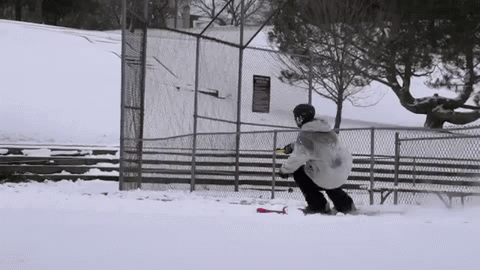
Karl Fostvedt in Detroit, 2014. Courtesy of Poor Boyz Productions
Atlas Obscura: In terms of your most recent films, how do you decide where to go in the RV? What goes into deciding the itinerary for these trips?
Mack: Last winter we filmed Meanwhile In Canada, where we drove across the country to Halifax. So this year was a little bit different, because we didn’t really know what we were getting into. The first year, we had a bit more of an organized plan—we put the word out, so we had kids on Facebook messaging us the spots in their town, and we kind of hit up everyone we knew, so at each spot we had like four or five options. But that one was pretty organized. We didn’t really know what we were getting into in terms of RV life—like, it was pretty damn cold in the prairies.
Haha, yeah I could imagine.
Mack: But, this year for Ski The North we had literally no plan, we were planning on, and told our sponsors that we were going to produce three different webisodes, and going out to the Kootenay Mountains. But the weather sucked, so we decided, screw it, we’re just going to make one big video. So we just decided to go up to Whitehorse [Yukon], with literally zero plans—we didn’t know of any good rails to hit, anywhere. So that was pretty hack in the way we found stuff.

Charles Gagnier using walls as landings. Quebec, 2011. Courtesy of GSL Productions
For your skiing style, what do you look for at spots? What do you like to ski, versus other people?
Mack: We just look for really cool rails. Or jump spots. I really like urban jumping right now. We kind of just discuss it, driving around a new city in the RV. But I mean, even if it’s something that we don’t particularly want to ski, that doesn’t fit our styles, but it will look legit on film, we’ll hit it. Some things are really fun to ski on, but they look bad on film. Other things are really awful to ski, but those are the ones that produce the best shots because it’s scary, or has high consequences if we fall.
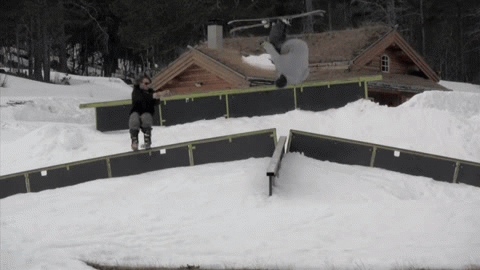 Andreas Hatveit shreds his backyard rail park, 2013. Courtesy of Andreas Hatveit
Andreas Hatveit shreds his backyard rail park, 2013. Courtesy of Andreas Hatveit
So what kind of questions do people ask you when they come across you guys shooting? What kind of conversations come out of that?
Mack: Well they always ask the trump card question, “Why don’t you guys just go to a ski hill?” And they are totally right: the ski hill is safer, there’s actual snow, and it’s not nearly as dangerous. But usually people just ask us what we’re doing, or what were doing it for, and, “Can we find you guys on YouTube?” Most people like us, but it’s best to just be really nice.

Tom Wallisch, one of the best competition skiers today, playing in the streets of Salt Lake City in 2008. Courtesy of Level 1
Right, right, that makes sense, try not to ruin the spot if more people want to come try it.
Mack: Okay, so here’s a story for you. We were in Brandon, Manitoba. We were skiing this cool double-elbow rail [a rail with two sharp bends in it] … and the janitor comes out, and he’s like, “What the hell are you guys doing? It’s minus forty, and you have your ski gear on.”
And were like, “Yeah man, just having some fun, doing a bit of skiing.” I think he literally thought we were trying to make little turns down the hill. So we sessioned the rail for another few hours, got all of our shots. Literally thirty seconds after Rob got his shot, he [the janitor] comes back out, and goes, “Are you guys actually serious, skiing on the handrail? I thought you were just skiing down the little hill.” So we got kicked out instantly after that. But yeah, just goes to show being ambiguous is the best way.
You gotta give other people a chance to hit the spot, and if you are respectful to the security guards, maybe more people will get to do it.
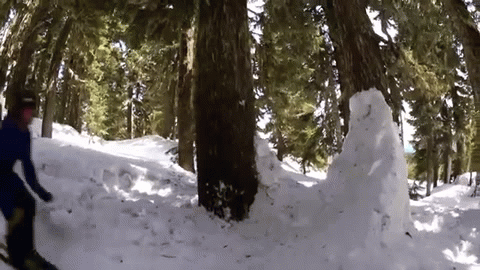
Will Wesson flips through trees in Colorado, 2015. Courtesy of the Line Traveling Circus
What kind of equipment do you usually bring on shoots?
Mack: You need a winch. They are pretty rare though. We’ll take it to a mechanic, and some have never even seen one. It’s literally like a motorcycle motor attached to a spool of rope, with a wakeboard handle. And they pull you pretty fast. You also need all the stuff for the shoot—generator, shovels, cameras, lights if you’re shooting at night. The winch allows us to hit features that would have been unimaginable ten years ago.
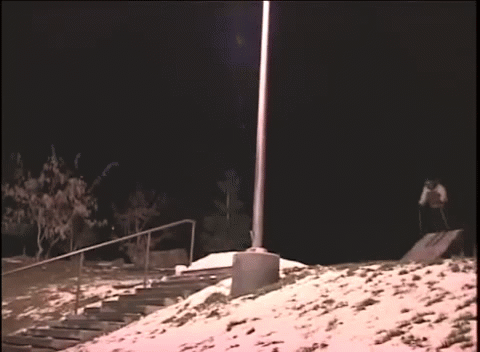 Tanner Hall in Salt Lake City, Utah, in 2004. Courtesy of Steven Rozendaal
Tanner Hall in Salt Lake City, Utah, in 2004. Courtesy of Steven Rozendaal
In terms of the ski industry, how much support do you get? You obviously aren’t a competition skier. Has your support increased or decreased, or changed at all in recent years?
Mack: I’d say support has gone down. I get a budget to pay for projects. I have a travel budget from my sponsors—it’s there, but sometimes hard to make it work. It’s like the one percent versus the masses. There’s seriously only like 10 guys that have viable enough contracts with their sponsors to support their life. Skiing to them is like a legitimate career. For the rest of us, it’s just fun, and it’s still competitive. Even though you’re not in competitions, you want to get the coolest stuff done so you can get more money to do more projects.
One of the most acclaimed ski-movie segments of the last few years was filmed in abandoned factories and warehouses in Detroit.
Cory: I mean, no one is really trying to make money off of this, they just want to produce a good film. People just want the budget to do what they want to do.
Mack: It’s dangerous, and usually uncomfortable, so you wouldn’t do it unless you really loved it. Like, why would you go freeze your ass off and risk injury? It’s not for money. I don’t know anyone that’s in skiing because they see it as a way to make money, and the people that do make money, they love it, and they’re really good at it, and they are just happy to ski, and making income on the side is just a bonus.
 Combining frisbee golf with flips. Norway, 2015. Courtesy of Real Skifi
Combining frisbee golf with flips. Norway, 2015. Courtesy of Real Skifi
Alright, so if you had to explain what you do to someone who’s never skied before, what would you say?
Mack/Cory: Haha, that’s actually a really hard question.
Mack: I’d say it’s the result of a natural progression. It started with moguls in the ’70s, and then park [terrain park skiing on mountains], and then obviously people want to explore options, so the street skiing scene grew as the sport grew. It’s like, we’ve done these tricks on the mountain, and we look around, and there’s all these handrails and ledges and stairs around us, of course we are going to try our tricks there, too. It’s cool to branch out into the cities, and having to work a little harder and be more creative to ski well. It’s definitely shaken up skiing, what was a pretty traditional, old sport.
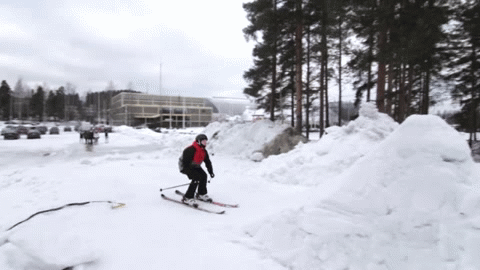
Real Skifi doing the most insane tricks, always. Norway, 2015. Courtesy of Real Skifi
It’s definitely an interesting idea: Urban skiing is cool because kids that are growing up in non-traditional ski areas, finally have the resources and the inspiration to get out there and ski. You don’t have to be in British Columbia or Alaska to have a great day on skis.
Mack: It’s so cool. And that’s the whole point of the RV projects that Rob and I do. You can go to places that aren’t ski towns. One of my favorite places to ski is Saskatoon [in Saskatchewan]. They have awesome rails, really friendly people, and no one skis there. You can make something from nothing—as little as a stair set or handrail.
I think it makes skiing way more accessible to everyone. If you have ski gear, you can ski. You don’t have to go and spend hundreds of dollars on lift passes or anything. It’s cool you can go out and ski on a thing that was never designed to be skied on, and you can build it with snow that falls from the sky. You don’t have to pay for that either, you shovel it up, sculpt it however you imagine. You get to spend time working with your friends outside, and then you start doing tricks. It’s that feeling of accomplishment that makes everything entirely worth it, even though it’s not really glamorous or fun at the time. it’s freezing cold out, usually, but the results are always great.
Mack and Rob’s 30-day ski adventure across northern Canada.


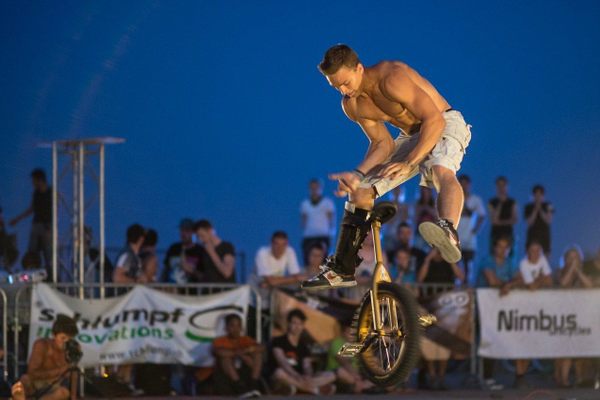









Follow us on Twitter to get the latest on the world's hidden wonders.
Like us on Facebook to get the latest on the world's hidden wonders.
Follow us on Twitter Like us on Facebook